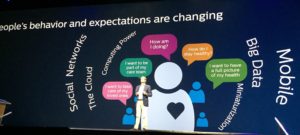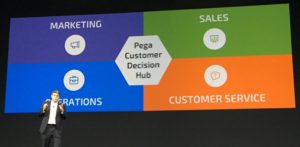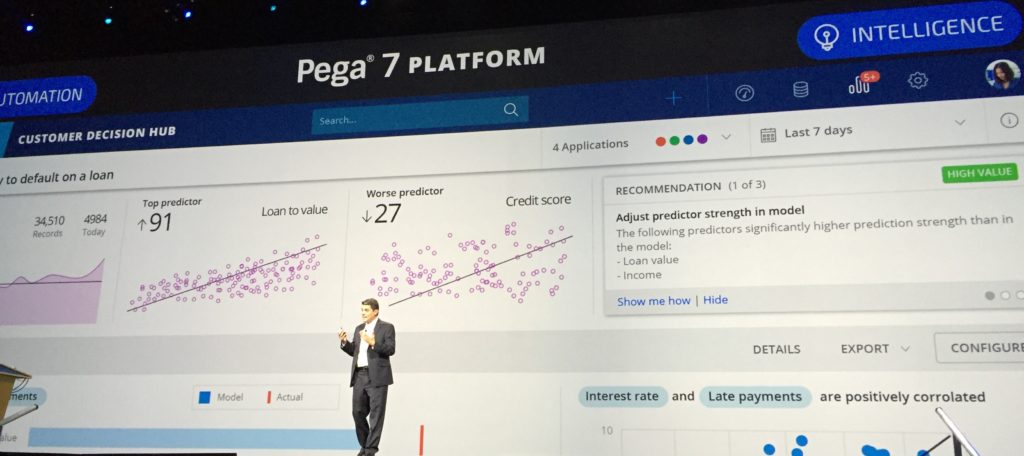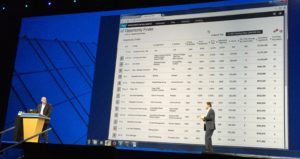It seems like I was just here in Vegas at the MGM Grand…oh, wait, I was just here. Well, I’m back for Pegaworld 2016, and 4,000 of us congregated in the Grand Garden Arena for the opening keynote on the first day. If you’re watching from home, or want to catch a replay, there is a live stream of the keynotes that will likely feature an on-demand replay at some point.
 Alan Trefler, Pega’s CEO, kicked things off by pointing out the shift from a focus on technology to a focus on the customer. Surveys show that although most companies think that they understand their customers, the customers don’t agree; companies need to undergo a serious amount of digital transformation in order to provide the level of service that today’s customers need, while still improving efficiencies to support that experience. One key to this is a model-driven technology environment that incorporates insights and actions, allowing the next best action to be provided at any given point depending on the current context, while supporting organizational evolution to allow constant change to meet the future demands. Model-driven environments let you create applications that are future-proof, since it is relatively quick to make changes to the models without changing a lot of code. Pega has a lot of new online training at the Pega Academy, a marketplace of third-party Pega applications at the Pega Exchange, and the continuing support of their Pega Express easy-to-use modeler; they continue to work on breaking free from their tech-heavy past to support more agile digital transformation. Pega recently sponsored an Economist report on digital transformation; you can grab that here.
Alan Trefler, Pega’s CEO, kicked things off by pointing out the shift from a focus on technology to a focus on the customer. Surveys show that although most companies think that they understand their customers, the customers don’t agree; companies need to undergo a serious amount of digital transformation in order to provide the level of service that today’s customers need, while still improving efficiencies to support that experience. One key to this is a model-driven technology environment that incorporates insights and actions, allowing the next best action to be provided at any given point depending on the current context, while supporting organizational evolution to allow constant change to meet the future demands. Model-driven environments let you create applications that are future-proof, since it is relatively quick to make changes to the models without changing a lot of code. Pega has a lot of new online training at the Pega Academy, a marketplace of third-party Pega applications at the Pega Exchange, and the continuing support of their Pega Express easy-to-use modeler; they continue to work on breaking free from their tech-heavy past to support more agile digital transformation. Pega recently sponsored an Economist report on digital transformation; you can grab that here.
 Don Schuerman, Pega’s CTO, took over as MC for the event to introduce the other keynote speakers, but first announced a new partnership with Philips that links Pega’s care management package with Philips’ HealthSuite informatics and cloud platform for home healthcare. Jeroen Tas, CEO of Connected Care & Health Informatics at Philips presented more on this, specifically in the context of the inefficient and unevenly-distributed US healthcare system. He had a great chart that showed the drivers for healthcare transformation: from episodic to continuous, by orchestrating 24/7 care; from care provider to human-centric, by focusing on patient experience; from fragmented to connected, by connecting patients and caregivers; and from volume to value, by optimizing resources. Connected, personalized care links healthy living to disease prevention, and supports the proper diagnosis and treatment since healthcare providers all have access to a comprehensive set of the patient’s information. Lots of cool personal healthcare devices, such as ultrasound-as-a-service, where they will ship a device that can be plugged into a tablet to allow your GP to do scans that might normally be done by a specialist; continuous glucose meters and insulin regulation; and tools to monitor elderly patients’ medications. Care costs can be reduced by 26% and readmissions reduced by 52% through active monitoring in networked care delivery environments, such as by monitoring heart patients for precursors of a heart attack; this requires a combination of IoT, personal health data, data analytics and patient pathways provided by Philips and Pega. He ended up stating that it’s a great time to be in healthcare, and that there are huge benefits for patients as well as healthcare providers.
Don Schuerman, Pega’s CTO, took over as MC for the event to introduce the other keynote speakers, but first announced a new partnership with Philips that links Pega’s care management package with Philips’ HealthSuite informatics and cloud platform for home healthcare. Jeroen Tas, CEO of Connected Care & Health Informatics at Philips presented more on this, specifically in the context of the inefficient and unevenly-distributed US healthcare system. He had a great chart that showed the drivers for healthcare transformation: from episodic to continuous, by orchestrating 24/7 care; from care provider to human-centric, by focusing on patient experience; from fragmented to connected, by connecting patients and caregivers; and from volume to value, by optimizing resources. Connected, personalized care links healthy living to disease prevention, and supports the proper diagnosis and treatment since healthcare providers all have access to a comprehensive set of the patient’s information. Lots of cool personal healthcare devices, such as ultrasound-as-a-service, where they will ship a device that can be plugged into a tablet to allow your GP to do scans that might normally be done by a specialist; continuous glucose meters and insulin regulation; and tools to monitor elderly patients’ medications. Care costs can be reduced by 26% and readmissions reduced by 52% through active monitoring in networked care delivery environments, such as by monitoring heart patients for precursors of a heart attack; this requires a combination of IoT, personal health data, data analytics and patient pathways provided by Philips and Pega. He ended up stating that it’s a great time to be in healthcare, and that there are huge benefits for patients as well as healthcare providers.
Although Tas didn’t discuss this aspect, there’s a huge amount of fear of connected healthcare information in user-pay healthcare systems: people are concerned that they will be refused coverage if their entire health history is known. Better informatics and analysis of healthcare information improves health and reduces overall healthcare costs, but it needs to be provided in an environment that doesn’t punish people for exposing their health data to everyone in the healthcare system.
We continued on the healthcare topic, moving to the insurance side with Birgit König, CEO of Allianz Health Germany. Since basic healthcare in Germany is provided by the state, health insurance is for additional services not covered by the basic plan, and for travelers while they are outside Germany. There is a lot of competition in the market, and customer experience for claims is becoming a competitive differentiator especially with new younger customers. In order to accommodate, Allianz is embracing a bimodal architecture approach, where back-end systems are maintained using traditional development techniques that focus on stability and risk, while front-end systems are more agile and innovative with shorter release cycles. I’ve just written a paper on bimodal IT and how it plays out in enterprises; not published yet, but completely aligned with what König discussed. Allianz is using Pega for more agile analytics and decisioning at the front end of their processes, while keeping their back-end systems stable. Innovation and fast development has been greatly aided by co-locating their development and business teams, not surprisingly.
 The keynote finished with Kerim Akgonul, Pega’s SVP of Products, for a high-level product update. He started by looking at the alignment between internal business goals and the customer journey, spanning marketing, sales, customer service and operations. The Pega Customer Decision Hub sits at the middle of these four areas, linking information so that (for example), offers sent to customers are based on their past orders.
The keynote finished with Kerim Akgonul, Pega’s SVP of Products, for a high-level product update. He started by looking at the alignment between internal business goals and the customer journey, spanning marketing, sales, customer service and operations. The Pega Customer Decision Hub sits at the middle of these four areas, linking information so that (for example), offers sent to customers are based on their past orders.

- Marketing: A recent Forrester report stated that Pega Marketing yields an 8x return on marketing investment (ROMI) due to the next-best-action strategies and other smart uses of analytics. Marketers don’t need to be data scientists to create intelligent campaigns based on historical and real-time data, and send those to a targeted list based on filters including geolocation. We saw this in action, with a campaign created in front of us to target Pegaworld attendees who were actually in the arena, then sent out to the recipients via the conference mobile app.
- Sales: The engagement map in the Pega Sales Automation app uses the Customer Decision Hub information to provide guidance that links products to opportunities for salespeople; we saw how the mobile sales automation app makes this information available and recommends contacts and actions, such as a follow-up contact or training offer. There are also some nice tools such as capturing a business card using the mobile camera and importing the contact information, merging it if a similar record is found.
 Customer service: The Pega customer service dashboard shows individual customer timelines, but the big customer service news in this keynote is the OpenSpan acquisition that provides robotic process automation (RPA) to improve customer service environments. OpenSpan can monitor desktop work as it is performed, and identify opportunities for RPA based on repetitive actions. The new automation is set up by recording the actions that would be done by a worker, such as copying and pasting information between systems. The example was an address change, where a CSR would take a call from a customer then have to update three different systems with the same information by copying and pasting between applications. We saw the address change being recorded, then played back on a new transaction; this was also included as an RPA step in a Pega Express model, although I’m not sure if that was just to document the process as opposed to any automation driven from the BPM side.
Customer service: The Pega customer service dashboard shows individual customer timelines, but the big customer service news in this keynote is the OpenSpan acquisition that provides robotic process automation (RPA) to improve customer service environments. OpenSpan can monitor desktop work as it is performed, and identify opportunities for RPA based on repetitive actions. The new automation is set up by recording the actions that would be done by a worker, such as copying and pasting information between systems. The example was an address change, where a CSR would take a call from a customer then have to update three different systems with the same information by copying and pasting between applications. We saw the address change being recorded, then played back on a new transaction; this was also included as an RPA step in a Pega Express model, although I’m not sure if that was just to document the process as opposed to any automation driven from the BPM side.- Operations: The Pega Field Service application provides information for remote workers doing field support calls, reducing the time required to complete the service while documenting the results and tracking the workers. We saw a short video of Xerox using this in Europe for their photocopier service calls: the field engineer sees the customer’s equipment list, the inventory that he has with him, and other local field engineers who might have different skills or inventory to assist with his call. Xerox has reduced their service call time, improved field engineer productivity, and increased customer satisfaction.
Good mix of vision, technology and customer case studies. Check out the replay when it’s available.





